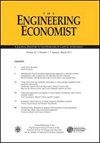编辑来信
IF 1
4区 经济学
Q4 BUSINESS
引用次数: 0
摘要
《工程经济学人》寻求多个领域的意见书,包括但不限于资本投资分析、财务风险管理、成本估算和会计、资本成本、设计经济学、经济决策分析、工程经济教育、研究与开发、,以及与工程师和技术经理所做的经济投资决策相关的公共政策分析。本期包含三篇文章,主要介绍其中一个领域,即财务风险管理。我要感谢所有为同行评审过程做出贡献的评审员,以及副主编Dave Enke和Sarah Ryan(前主编)对本期的贡献。本期以Gordon Hazen和我们自己的地区编辑Carlo Magni Alberto的一篇题为“风险项目的平均内部回报率”的文章开头。他们的工作将之前关于平均内部收益率(AIRR)的工作扩展到了风险资本资产项目,这是一个内部收益率似乎难以处理的领域。他们表明,分析师可以唯一地将风险NPV分解为风险敏感的项目规模和风险敏感的扩展AIRR,代表风险项目效率,从而在确定性等价意义上保持接受/拒绝决策与NPV的一致性,直接类似于确定性情况。这种新颖的细分通过帮助确定风险项目的不确定性来源,无论是项目规模还是经济效率,或两者兼而有之,提供了管理洞察力。在Kyoung Kuk Kim、Dowon Kim和Jiwoong Lee的“平滑歧义下的期限结构和基于情景的社会折现率”中,探讨了基于拉姆齐规则的社会折现比率。为了反映决策者对风险和不确定性的态度,该规则以各种方式进行了扩充。作者利用效用梯度法建立了一个通用的社会折现率公式,得到了风险厌恶、跨期替代和歧义厌恶的三元显式分离。这种方法的普遍性使得能够直接应用气候变化下众所周知的增长情景来推导基于情景的社会贴现率,这可以作为评估气候变化政策或相关项目的实践指南。在上一篇文章中,区域编辑Roy Kwon、David Islip和Jason Wei合著了《用天气衍生品管理建筑风险》。作者指出,在建筑行业参与者中,天气被认为是影响项目现金流的最关键因素之一。本文提出了一个框架,该框架利用建筑业的程式化事实来激励在管理非琐碎的天气影响时使用天气衍生品。他们表明,承包商用于对冲目的的天气衍生品投资组合可以解决承包商对损失的厌恶以及天气和施工之间的复杂关系。《工程经济学人》发表文章、案例研究、调查以及书籍和软件评论,代表涉及资本投资问题的原始研究、当前实践和教学。如有疑问或咨询,请联系我:hln@uark.edu.本文章由计算机程序翻译,如有差异,请以英文原文为准。
Letter from the Editor
The Engineering Economist seeks submissions in a number of areas, including but not limited to capital investment analysis, financial risk management, cost estimation and accounting, cost of capital, design economics, economic decision analysis, engineering economy education, research and development, and the analysis of public policy when it is relevant to the economic investment decisions made by engineers and technology managers. This issue contains three articles that primarily contribute one of these areas, financial risk management. I would like to thank all reviewers who contributed to the peer-review process as well as associate editors Dave Enke and Sarah Ryan (former editor-in-chief) for their contributions to this issue. The issue begins with an article entitled “Average Internal Rate of Return for Risky Projects” by Gordon Hazen and one of our own area editors Carlo Magni Alberto. Their work extends prior work on average internal rate of return (AIRR) to risky capital asset projects, a domain where the IRR appears intractable. They show that an analyst can uniquely break down a risky NPV into a risk-sensitive project scale and a risk-sensitive extended AIRR, representing risky project efficiency, so that consistency with NPV for accept/reject decisions is maintained in the certainty-equivalent sense, in direct analogy to the deterministic case. This novel breakdown gives managerial insight by helping determine a risky project’s locus of uncertainty, be it the project scale, or economic efficiency, or both. In “Term Structures and Scenario-Based Social Discount Rates under Smooth Ambiguity” by Kyoung-Kuk Kim, Dowon Kim, and Jiwoong Lee, social discount rates based on the Ramsey rule are explored. The rule has been augmented in various ways in order to reflect the decision maker’s attitude toward risk and uncertainty. The authors develop a general social discount rate formula via the utility gradient method, which obtains the three-way explicit separation of risk aversion, intertemporal substitution, and ambiguity aversion. The generality of this approach enables directly applying well known growth scenarios under climate change to derive scenario-based social discount rates, which can be used as a guide in practice to assess climate change policies or related projects. In the last article, area editor Roy Kwon, David Islip, and Jason Wei coauthor “Managing Construction Risk with Weather Derivatives.” The authors state that among construction industry participants, weather has been perceived to be one of the most critical factors impacting project cash-flows. This article presents a framework that leverages stylized facts from the construction industry to motivate the use of weather derivatives in managing the non-trivial weather impacts. They show that weather derivative portfolios used for hedging purposes by the contractor can address the contractor’s aversion for losses as well as the complicated relationship between weather and construction. The Engineering Economist publishes articles, case studies, surveys, and book and software reviews that represent original research, current practice, and teaching involving problems of capital investment. For questions or inquiries, please contact me at hln@uark.edu.
求助全文
通过发布文献求助,成功后即可免费获取论文全文。
去求助
来源期刊

Engineering Economist
ENGINEERING, INDUSTRIAL-OPERATIONS RESEARCH & MANAGEMENT SCIENCE
CiteScore
2.00
自引率
0.00%
发文量
14
审稿时长
>12 weeks
期刊介绍:
The Engineering Economist is a refereed journal published jointly by the Engineering Economy Division of the American Society of Engineering Education (ASEE) and the Institute of Industrial and Systems Engineers (IISE). The journal publishes articles, case studies, surveys, and book and software reviews that represent original research, current practice, and teaching involving problems of capital investment.
The journal seeks submissions in a number of areas, including, but not limited to: capital investment analysis, financial risk management, cost estimation and accounting, cost of capital, design economics, economic decision analysis, engineering economy education, research and development, and the analysis of public policy when it is relevant to the economic investment decisions made by engineers and technology managers.
 求助内容:
求助内容: 应助结果提醒方式:
应助结果提醒方式:


